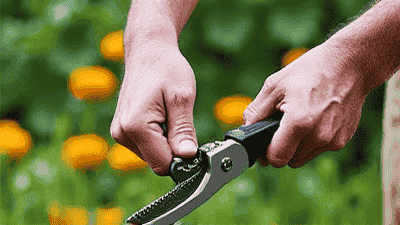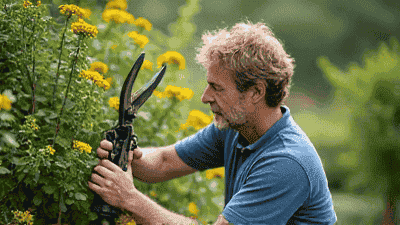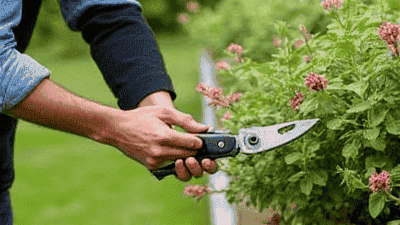Basic pruning techniques for maintaining herbaceous plants
Pruning is a critical practice in horticulture that helps maintain the health and productivity of herb plants. Whether you're growing herbs for culinary use, medicinal purposes, or simply for their aromatic qualities, regular pruning will ensure that your plants remain vigorous and flavorful.

Understanding the Importance of Pruning
Pruning is not merely about cutting back plants; it is an art and science that enhances their growth and productivity. For herb plants, proper pruning can promote bushier growth, improve air circulation, and prevent diseases. It also encourages the development of new foliage and prevents leggy or spindly growth, which is crucial for herbs that are harvested frequently.
Benefits of Pruning Herbs
Promotes Bushier Growth: Regular pruning encourages lateral growth, leading to a fuller, bushier plant. This is especially important for culinary herbs, as a bushy plant yields more leaves.
Enhances Flavor and Aroma: Pruning stimulates the growth of new foliage, which is often more pungent and flavorful than older leaves.
Improves Air Circulation: Removing crowded or diseased foliage increases air circulation around the plant, reducing the likelihood of fungal infections and pests.
Extends Harvest Period: By pruning regularly, you can encourage new growth and sustain a longer harvest period throughout the growing season.
Removes Dead or Damaged Material: Pruning helps maintain the overall health of the plant by removing dead, damaged, or diseased leaves and stems.
Basic Pruning Techniques

When it comes to pruning herb plants, several basic techniques can be used. Let's explore these methods along with specific tips for popular herbs.
1. Pinching
Pinching is a simple pruning technique that involves using your fingers to remove the growing tips of the plant. This method is commonly used on soft-stemmed herbs, such as basil, mint, and parsley.
How to Pinch
- Identify the plant’s growing tips, which are typically located at the end of the stems.
- Using your thumb and index finger, gently pinch off the top 1-2 inches of growth.
- Pinch above a leaf node, which is the point where leaves attach to the stem. This encourages the plant to produce two new stems from the node, promoting bushiness.
2. Shearing
Shearing involves cutting back a significant portion of the plant’s foliage to shape it and remove spent flowers. This technique is effective for herbs like chives, thyme, and oregano.
How to Shear
- Use sharp garden shears or scissors to cut back the top one-third to half of the plant.
- Focus on removing spent flowers and any weak or leggy growth, while maintaining a healthy structure.
- Make clean cuts to prevent damage to the plant, and avoid cutting into dead or brown stems.
3. Selective Pruning
Selective pruning involves cutting specific stems or branches to improve the plant's overall structure and health. This method is commonly used for woody herbs such as rosemary and sage.
How to Selectively Prune
- Identify any dead, damaged, or diseased stems and remove them at the base.
- Trim back overly vigorous growth and any crossing branches that may rub against each other.
- Focus on maintaining an open center for better air circulation and light penetration.
4. Deadheading
Deadheading is the practice of removing spent flowers from herb plants to encourage further blooming and prevent the plant from going to seed. This technique is often used with flowering herbs such as chamomile and borage.
How to Deadhead
- Identify spent flowers that have begun to wilt or brown.
- Use scissors or pruning shears to cut off the flower stems just above a set of leaves or a leaf node.
- Regular deadheading can lead to a longer blooming period and promote new growth.
Pruning Techniques for Specific Herbs
Now that we've covered the basic pruning techniques, let's look at how to apply these methods to some popular herb plants.
Basil
Basil is a vigorous plant that benefits greatly from regular pruning. To maximize your harvest and promote bushiness, follow these guidelines.
- Pinch regularly: Start pinching basil as soon as it develops about six leaves. Pinching the tops encourages lateral growth, leading to a fuller plant.
- Remove flower buds: If flowers begin to appear, pinch them off immediately to prevent the plant from bolting, which causes the leaves to become bitter.
Mint
Mint is known for its rapid growth, and proper pruning is essential to keep it in check.
- Pinch or shear: Pinch back the tops of the stems throughout the growing season to encourage bushier growth and prevent leggy plants.
- Control size: Regularly shear the plant back by one-third to maintain its shape and discourage flowering, which can alter the flavor of the leaves.
Oregano
Oregano thrives with regular harvesting and pruning.
- Selective pruning: Remove up to one-third of the plant's height by cutting back the stems just above a leaf node. This encourages new growth and ensures a continuous harvest.
- Spring cleanup: In early spring, cut back any brown or dead stems to promote fresh growth.
Rosemary
Rosemary is a woody herb that requires selective pruning to maintain its health.
- Trim selectively: Remove dead or damaged branches at the base to improve air circulation. Avoid cutting into the woody stems, as this can inhibit growth.
- Shape the plant: Lightly shear the tips of the branches to promote bushiness and prevent the plant from becoming too leggy.
Thyme
Thyme is a low-growing herb that benefits from both selective pruning and shearing.
- Regular shearing: At the start of the growing season, shear back the plant by one-third to promote new growth and maintain a tidy appearance.
- Deadheading: Remove any flowers that appear to prolong the harvest of fresh leaves.
Sage
Sage can benefit from both selective pruning and shearing.
- Selective pruning: Cut back any dead or weak stems to encourage new growth and maintain a healthy plant structure.
- Spring shearing: In early spring, shear the plant back by one-third to rejuvenate it for the growing season.
Best Practices for Pruning Herb Plants

To ensure successful pruning of your herb plants, consider the following best practices.
1. Use Clean, Sharp Tools
Always use clean and sharp pruning shears or scissors to prevent damage to the plant and reduce the risk of disease transmission. Sterilizing your tools before and after use can help maintain plant health.
2. Prune at the Right Time
The best time to prune most herbs is in the spring or early summer, during their active growth phase. Avoid heavy pruning during late fall or winter when the plants are dormant. For most herbs, regular light pruning throughout the growing season will yield the best results.
3. Observe Plant Health
Keep an eye on the overall health of your herb plants. If you notice yellowing leaves, slow growth, or signs of disease, evaluate your pruning techniques and adjust as needed. Healthy plants will respond better to pruning.
4. Avoid Over-Pruning
While regular pruning is important, over-pruning can stress the plant and stunt its growth. Aim to remove no more than one-third of the plant's foliage at any given time.
5. Water After Pruning
After pruning, it’s a good idea to water your herb plants thoroughly. This will help support new growth and reduce transplant shock if you have removed a significant amount of foliage.
6. Monitor for Pests and Diseases
Regular pruning can expose plants to pests and diseases. After each pruning session, inspect your herbs for any signs of infestations or infections. Taking early action can help prevent larger problems down the road.
Conclusion
Pruning is an essential skill for maintaining healthy and productive herb plants. By employing basic pruning techniques and observing best practices specific to different herbs, you can enhance their growth, flavor, and overall vitality. Remember that proper pruning not only benefits your plants but also ensures a more abundant and enjoyable harvest.
Whether you are new to herb gardening or have a seasoned garden, incorporating regular pruning into your routine will help you achieve thriving, aromatic herbs that enhance your culinary endeavors and enrich your garden experience.
